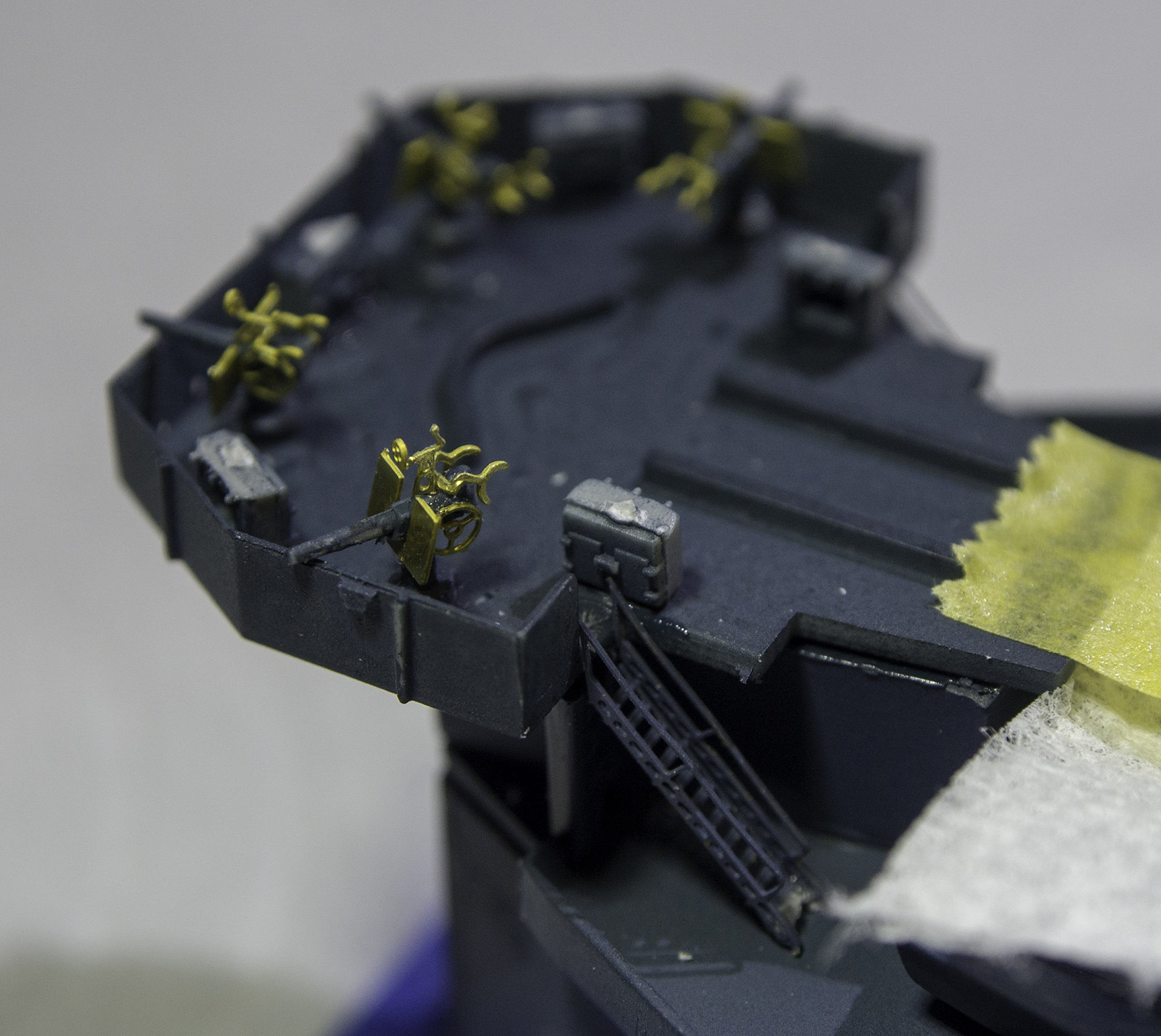Spent a lot of time today making some very small things…
I made another searchlight to replace the one that’s missing. I turned a cylinder the diameter of the prototype, 36" = 0.100" approx. at 1:350. I then turned a pedestal. This came out nicely, but as you’ll see it’s a bit tall. I could have made it shorter, but didn’t feel like making another. The only way you know is if you look at the ship head-on and see port and starboard lights at the same time.
Before parting the cylinder off the stock, I took it out of the lathe, put it in a v-block, filed a flat on the circumference so the center punch and drill would skitter off the circle, and then drilled with a 0.032" carbide drill in a pin vise. I had to drill through the center hole and had to be careful to keep it aligned and not break it. I use Tap Magic for brass when drilling and turnind which helps prevent grabbing which is notorious when machining brass with positively-raked cutting tools. Normally, brass tools are ground with 0 or negative rake angles to scrap the surface rather than cut into it. The rake angle is the back slope of the cutting edge. Positive rake has an acute angle falling back from the cutting lip. Even with drills, if they’re large enough to do this, you can grind a small flat behind the cutting edge to reduce the rake angle.
I made the bail with a piece of PE fret brass and turned the base with a 0.032" base pin and pin for the bail. I needed to set the hole spacing for the trunions. The cylinder was .100", and the trunion pins would lie on the diameter, so I multiplied .100 X pi, and then cut that in half and added 0.020" for some clearance. I could have added more, but the bail did fit over the pins. After soldering it all together, I trimmed the bail and filed off the trunions. I filled the center hole with solder to make a face. I was going to leave the hole, but the trunion passed through the middle.

Here’s the installed search light.

Next I built the GMM PE loudspeakers. They’re a three-part affair with a folded box, a perforated screen and a small folded bracket. I decided to solder these together after messing around, unsucessfully, with CA. The first one I made (which eventually flew out of a tweezers into the Rift) I soldered the screen and then attempted to solder the bracket. This was a mess. The next one, I soldered the bracket first and then soldered on the screen. This worked. But I lost a couple of the brackets, so the next two I made a bracket with a strap of PE brass. This actually worked even better. You can’t see that microscopic bracket anyway.
So I only had three of them at that moment. I CA’d the first one to the front wall of the flag bridge as shown in one of my diagrams. The other goes on the rail in the island’s middle. This didn’t want to settle down with CA, so I went with J-B. Since it sets very slowly, I laid the island over almost horizontal by swiveling the Panavise base into that position. It will be cured on Monday when work begins again. You can just see it below the radar antenna racks facing upward. The 3rd loudspeaker, which was supposed to go on the aft end of the island, flew out of my tweezers on the way to put some CA on its bracket and went into the Rift.

I started building the 20mm gun sets. GMM includes four PE pieces for each gun: shield, shoulder rests, gun sight and elevating wheel. Of these, the easiest to install was the shield, but I did have to rough up the brass at the glue site to give the CA something to stick to. I also put on a set of shoulder rests. I tried, successfully at first, to install the tiny gun sight, but it fell off and then got lost. I also tried to install the hand wheel, and it too fell off. So it took quite a while to get one done. I got the second one underway before dinner time. I’ve got to build 13 of them just for the island. I have a full set of 20mm PE guns left over on my MO Eduard set. These are a folded deal that already includes the shoulder rests, but lacks a base. The base pin is about 0.020" and could work (maybe) with the Trumpeter bases, or I could just turn a set of custom bases and solder the whole deal together including the shields. I have to think about this over the weekend.

That’s an #11 blade in the picture for scale comparison, so you can get a good idea about just how small that gun site is AND you have to rotate the circle site so it’s perpendicular to the barrel. It just has that tiny base to hold it to the gun barrel. It’s not a pretty thing and I’m not so sure it will be successful, at least for me. I am sure there are builders some where out there in this wide world that have the steadiness and techniques to build these micro-PE assemblies.
Here’s the completed one. The Trumpeter barrel is WAY out of scale. The Eduard ones are much closer to scale, but they lack that base. Nothing’s perfect. I’ve looked at some of those Korean and Chinese PE company products which have turned barrels and so much detail, but I can’t figure out how you’d build the darn things. At 1:200, you’d have a chance, but at 1:350, it seems almost impossible, based on my experience.



















































